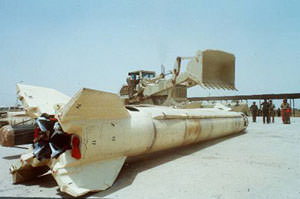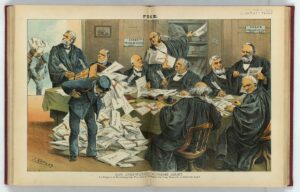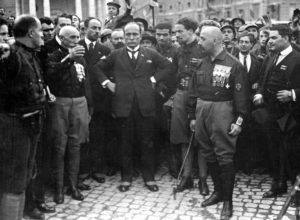The Nuclear Expert Who Never Was
As a former U.N. weapons inspector, Scott Ritter knows a thing or two about nuclear threats around the world. So when so-called experts go on television or appear in print to help make the case for war with Iran, it gets his attention.
Editor’s note: Frank von Hippel has written a response to this column in the comments below. Click here to read his rebuttal.
I am a former U.N. weapons inspector. I started my work with the United Nations in September 1991, and between that date and my resignation in August 1998, I participated in over 30 inspections, 14 as chief inspector. The United Nations Special Commission, or UNSCOM, was the organization mandated by the Security Council with the implementation of its resolutions requiring Iraq to be disarmed of its weapons-of-mass-destruction capabilities. While UNSCOM oversaw the areas of chemical and biological weapons, and ballistic missiles, it shared the nuclear file with the International Atomic Energy Agency, or IAEA. As such, UNSCOM, through a small cell of nuclear experts on loan from the various national weapons laboratories, would coordinate with the nuclear safeguards inspectors from the IAEA, organized into an “Action Team” dedicated to the Iraq nuclear disarmament problem. UNSCOM maintained political control of the process, insofar as its executive chairman was the only one authorized to approve a given inspection mission. At first, the IAEA and UNSCOM shared the technical oversight of the inspection process, but soon this was transferred completely to the IAEA’s Action Team, and UNSCOM’s nuclear staff assumed more of an advisory and liaison function.
In August 1992 I began cooperating closely with IAEA’s Action Team, traveling to Vienna, where the IAEA maintained its headquarters. The IAEA had in its possession a huge cache of documents seized from Iraq during a series of inspections in the summer of 1991 and, together with other U.N. inspectors, I was able to gain access to these documents for the purpose of extracting any information which might relate to UNSCOM’s non-nuclear mission. These documents proved to be very valuable in that regard, and a strong working relationship was developed. Over the coming years I frequently traveled to Vienna, where I came to know the members of the IAEA Action Team as friends and dedicated professionals. Whether poring over documents, examining bits and pieces of equipment (the IAEA kept a sample of an Iraqi nuclear centrifuge in its office) or ruminating about the difficult political situation that was Iraq over wine and cheese on a Friday afternoon, I became familiar with the core team of experts who composed the IAEA Action Team.
I bring up this history because during the entire time of my intense, somewhat intimate cooperation with the IAEA Action Team, one name that never entered into the mix was David Albright. Albright is the president of the Institute for Science and International Security (ISIS, an institute which he himself founded), and has for some time now dominated the news as the “go-to” guy for the U.S. mainstream media when they need “expert opinion” on news pertaining to nuclear issues. Most recently, Albright could be seen commenting on a report he authored, released by ISIS on June 16, in which he discusses the alleged existence of a computer owned by Swiss-based businessmen who were involved in the A.Q. Khan nuclear black market ring. According to Albright, this computer contained sensitive design drawings of a small, sophisticated nuclear warhead which, he speculates, could fit on a missile delivery system such as that possessed by Iran.
I have no objection to an academically based think tank capable of producing sound analysis about the myriad nuclear-based threats the world faces today. But David Albright has a track record of making half-baked analyses derived from questionable sources seem mainstream. He breathes false legitimacy into these factually challenged stories by cloaking himself in a résumé which is disingenuous in the extreme. Eventually, one must begin to question the motives of Albright and ISIS. No self-respecting think tank would allow itself to be used in such an egregious manner. The fact that ISIS is a creation of Albright himself, and as such operates as a mirror image of its founder and president, only underscores the concerns raised when an individual lacking in any demonstrable foundation of expertise has installed himself into the mainstream media in a manner that corrupts the public discourse and debate by propagating factually incorrect, illogical and misleading information.
In his résumé Albright prominently advertises himself as a “former U.N. weapons inspector.” Indeed, this is the first thing that is mentioned when he describes himself to the public. Witness an Op-Ed piece in The Washington Post which he jointly authored with Jacqueline Shire in January 2008, wherein he is described as such: “David Albright, a former U.N. weapons inspector, is president of the Institute for Science and International Security.” His erstwhile U.N. credentials appear before his actual job title. Now, this is not uncommon. I do the same thing when describing myself, noting that I was a former U.N. weapons inspector in Iraq from 1991 to 1998. I feel comfortable doing this, because it’s true and because my résumé is relevant to my writing. In his official ISIS biography, Albright details his “U.N. inspector” experience as such: “Albright cooperated actively with the IAEA Action Team from 1992 until 1997, focusing on analyses of Iraqi documents and past procurement activities. In June 1996, he was the first non-governmental inspector of the Iraqi nuclear program. On this inspection mission, Albright questioned members of Iraq’s former uranium enrichment programs about their statements in Iraq’s draft Full, Final, and Complete Declaration.”
Now, as I have explained previously, I cooperated actively between 1992 and 1998 with the IAEA Action team, covering the same ground that David Albright claims to have. I do not doubt his assertion that he was in contact with the IAEA during the period claimed; I just doubt the use of the word actively to describe this cooperation. Maybe Albright was part of a top-secret “shadow” inspection activity that I was unaware of. I strongly doubt this. In 1992, when Albright states he began his “active cooperation” with the IAEA, he was serving as a “Senior Staff Scientist” with the Federation of American Scientists. That same year Albright, in collaboration with Frans Berkhout of Sussex University and William Walker of the University of St. Andrews, published “World Inventory of Plutonium and Highly Enriched Uranium,” 1992 (SIPRI and Oxford University Press). From March 1991 until July 1992, Albright, together with Mark Hibbs, wrote a series of seven articles on the Iraqi nuclear weapons programs for the Bulletin of the Atomic Scientists. The final three articles of this series, entitled “Iraq’s Bomb: Blueprints and Artifacts,” “Iraq: It’s all over at Al Atheer” and “Iraq’s shop-till-you-drop nuclear program,” were in part based upon information provided to Albright and Hibbs by the IAEA in response to questions posed by the two authors. So far as I can tell, this is the true nature of David Albright’s “active cooperation.” Far from being a subject-matter expert brought in by the IAEA to review Iraqi documents, Albright was simply an outsider with questions.In the November/December 1995 issue of the Bulletin of the Atomic Scientists, Albright wrote an article, co-authored with Robert Kelley, titled “Has Iraq come clean at last?” I know Bob Kelley. In August 1992, it was Kelley, then deputy to Action Team leader Maurizio Zifferero, who helped me and other UNSCOM inspectors gain access to the Iraqi documents under IAEA control. Kelley was, and is, a great safeguards inspector, and among his many accomplishments is his leading role in directing the IAEA’s investigation into South Africa’s unilaterally dismantled nuclear weapons program in the mid-1990s. Bob Kelley had served as David Albright’s “in” at the IAEA since 1992, when he started providing Albright with access to some of the IAEA’s information on Iraq’s nuclear program. The decision to jointly author an article on Iraq was a big step toward legitimizing what had been, up until that time, an informal relationship.
The joint article with Kelley gave Albright a legitimacy within the IAEA, to the extent that there were no objections when Kelley recommended inviting Albright to participate in a surge of inspections. It was during the aftermath of the defection of Saddam Hussein’s son-in-law, Hussein Kamal, in August 1995, and the subsequent turning over of a massive quantity of previously hidden documents, including those pertaining to nuclear issues. These activities served as the framework around which Albright and Kelley wrote their article. The June 1996 inspection Albright participated in was his one and only foray into Iraq as a weapons inspector. He was not a chief inspector, nor a deputy chief inspector, nor an operations officer. He was a minor member of the team, Bob Kelley’s bag boy, who for the most part was there to observe. In a round-table discussion with Iraqi nuclear scientists, attended by all of the inspectors, Albright was able to ask a few questions, not from the standpoint of an IAEA expert, but more as an informed tourist.
I was in Iraq at the time, spearheading the very controversial UNSCOM 150 inspection, which found our team barred from entering several sensitive sites in and around Baghdad. On the few occasions when I was able to spend some down time at the U.N. headquarters on Canal Street, I would catch up with the status of the other inspections taking place in Iraq at the same time, including the one Albright was attached to. From all accounts, his lone stint as an inspector was at best unremarkable. He was a dilettante in every sense of the word, a Walter Mitty-like character in a world of genuine U.N. inspectors. There was recognition among most involved that bringing an outsider such as David Albright into the inspection process was a mistake. Not only did he lack any experience in the nuclear weapons field (being an outsider with only secondhand insight into limited aspects of the Iraqi program), he had no credibility with the Iraqi nuclear scientists, and his questions, void of any connectivity with the considerable record of interaction between the IAEA and Iraq, were not taken seriously by either side. Albright left Iraq in June 1996, and was never again invited back.
This is the reality of the relationship between Albright and the IAEA, and the singular event in his life which he uses as the justification for prominently promoting himself as a “former U.N. inspector.” While not outright fraud, Albright’s self-promoted relationship with the IAEA, and his status as a “former U.N. inspector,” is at best disingenuous, all the more so since he exploits this misleading biographical data in his ongoing effort to insert himself into the public eye as a nuclear weapons expert, a title not supported by anything in his life experience.
I can’t say for certain when Albright became “Doctor” Albright. A self-described “physicist,” he allows the term to linger, as he does the title “former U.N. inspector,” in order to create the impression that he possesses a certain gravitas. David Albright holds a master of science degree in physics from Indiana University and a master of science in mathematics from Wright State University. I imagine that this résumé permits him to assign himself the title physicist, but not in the Robert Oppenheimer/Edward Teller sense of the word. Whatever physics work Albright may or may not have done in his life, one thing is certain: He has never worked as a nuclear physicist on any program dedicated to the design and/or manufacture of nuclear weapons. He has never designed nuclear weapons and never conducted mathematical calculations in support of testing nuclear weapons, nor has he ever worked in a facility or with an organization dedicated to either.
At best, Albright is an observer of things nuclear. But to associate his sub-par physics pedigree with genuine nuclear weapons-related work is, like his self-promotion as a “former U.N. weapons inspector,” disingenuous in the extreme. His lack of any advanced educational training as a nuclear physicist, combined with his dearth of practical experience with things nuclear, is further exacerbated by his astounding assumption of the title Doctor. In 2007 Albright received an honorary doctorate of humane letters from Wright State University. This honorary award is a recognition that should never be belittled, but it in no way elevates Albright to the status of one who has undergone the formal educational training and has actually earned a doctorate, especially in the demanding field of nuclear physics. While I cannot find any evidence of Albright promoting his honorary title in a manner that indicates direct fraud on his part (i.e., falsely claiming to be a Ph.D. in physics), there are far too many instances where he is referred to by those who interview him as being both “Dr. Albright” and a “physicist” that the uninformed reader might be misled into believing that the two were somehow connected.
Albright has spent the past decade building a solid reputation as an analyst of nuclear issues. One only need look at the impressive work he and ISIS have done on the issue of North Korea to understand the potential he brings to the table as an outside observer on nuclear matters. Informed interest, combined with sustained access to critical personalities on both sides of an issue, makes for insights and opinions that contribute in a positive manner to the overall public discourse. No one who is interested in facilitating informed debate, discussion and dialogue about issues such as those facing us in North Korea, Iran and elsewhere can deny the value Albright brings to the table. That his insight into these matters should be shared with members of the media is likewise something that should be encouraged. But an analyst must be viewed in the proper perspective, and this begins by correctly defining who and what one is. David Albright is not a former U.N. weapons inspector, but rather an accidental tourist. To call oneself a weapons inspector suggests that one participated in the totality of the inspection process, and as such can converse readily, based on firsthand experience, about the total spectrum of issues that entails. Albright, based on his flimsy résumé in this regard, is not capable of such, and therefore should stop referring to himself in this manner, and encourage the media to do the same. Likewise, all reference to Albright as “Dr. Albright” should be eliminated, as should any reference which places the words physicist and nuclear in proximity. Let his work be judged on its own merit, and not camouflaged behind misleading perceptions created through false advertising.
In that he never has designed or worked in a nuclear reactor, never has designed or worked on nuclear weapons, in fact never has done anything of a practical, hands-on nature in the nuclear field, to call Albright an expert is a disservice to the term and, again, misleading in the extreme. It is not a sin to merely be informed, or to possess a specialty. But informed specialists are a dime a dozen. There is a reason mainstream media do not turn to bloggers when seeking out expert opinion. And yet, when they turn to “Dr. Albright, former U.N. weapons inspector,” they are getting little more than a well-funded, well-connected blogger. If one takes a closer look at the ISIS Report published by Albright on June 16 and widely quoted in the press since then, one will realize that there simply isn’t any substance to the allegations. Albright’s sole source seems to be a single, unnamed IAEA official, bringing to mind Bob Kelley and his role in facilitating Albright’s “access” to the IAEA in the 1990s. The remainder of the report comprises information already available to the general public, or sheer speculation.
This is, of course, the problem when someone who is not an expert on a given subject attempts to portray himself as just that. Lacking in the foundation of knowledge and experience which generally is expected of a genuine expert, the false “expert” commits error after error, not only of the factual sort but also in judgment. Had Albright in fact been a true nuclear expert, especially one fortified with firsthand experience as a former U.N. weapons inspector, he would not have had any association with Khidir Hamza, the disgraced Iraqi defector who claimed to have firsthand knowledge of Saddam Hussein’s nuclear program. A true nuclear expert would have recognized the technical impossibilities and inconsistencies in Hamza’s fabrications. And a genuine former U.N. weapons inspector would have known that Hamza had been fingered as a fraud by the IAEA and UNSCOM. David Albright instead employed Hamza as an analyst with ISIS from 1997 until 1999.
Albright likewise facilitated the story of former Iraqi nuclear scientist Mahdi Obeidi being told to the world. As a “former U.N. weapons inspector,” Albright had a passing knowledge of Obeidi; the Iraqi was among the scientists that the IAEA team Albright served on questioned in June 1996 (Albright himself claims to have personally questioned Obeidi). Albright helped sell Obeidi’s story about buried uranium centrifuge parts to the media, even though a true nuclear expert would have known that what Obeidi claims to have hidden possessed absolutely no value in the field of nuclear enrichment, and any former U.N. weapons inspector worth his or her salt would have recognized the inconsistencies and improbabilities in the Obeidi story.
David Albright has a history of being used by those who seek to gain media attention for their respective claims. In addition to the Hamza and Obeidi fiascos, Albright and his organization, ISIS, have served as the conduit for other agencies gaining publicity about the alleged Iranian nuclear weapons program, the alleged Syrian nuclear reactor, and most recently the alleged Swiss computer containing sensitive nuclear design information. On each occasion, Albright is fed sensitive information from a third party, and then packages it in a manner that is consumable by the media. The media, engrossed with Albright’s misleading résumé (“former U.N. weapons inspector,” “Doctor,” “physicist” and “nuclear expert”), give Albright a full hearing, during which time the particulars the third-party source wanted made public are broadcast or printed for all the world to see. More often than not, it turns out that the core of the story pushed by Albright is, in fact, wrong.
While Iran did indeed possess uranium enrichment capability at Natanz and a heavy water plant (under construction) at Arak (as reported by Albright thanks to information provided by the Iranian opposition group MEK, most probably with the help of Israeli intelligence), Albright’s wild speculation about weapons-grade plutonium and highly enriched uranium proved to be wrong. There was indeed a building in Syria that was bombed by Israel. But Albright’s expert opinion, derived from his interpretation of photographs, consists of nothing more than simplistic observation (“The tall building in the image may house a reactor under construction and the pump station along the river may have been intended to supply cooling water to the reactor”) combined with unfocused questions that assumed much, but were in fact based on little (“How far along was the reactor construction project when it was bombed? What was the extent of nuclear assistance from North Korea? Which reactor components did Syria obtain from North Korea or elsewhere, and where are they now?”). And, most recently, we have Albright commenting about the contents of a computer he hasn’t even laid eyes on, though he feels confident enough to raise the specter of global nuclear catastrophe (“How will authorities learn if Iran, North Korea, or even terrorists bought these designs?” Albright asks when referring to the contents of the Swiss computer).
Nowhere in his résumé does Albright cite any formal training as a photographic interpreter; in any case, one would have to have an intimate knowledge of nuclear facilities in order to know what one was looking at when examining an aerial image. A genuine nuclear weapons expert would have been able to discern the technical faults in the logic of the stories being peddled by Albright. And a genuine former U.N. weapons inspector, well versed in preparing airtight investigations based upon verified intelligence information, would have balked at the shabby nature of the evidence provided. Again, because Albright is neither, he and ISIS play the role of patsy, the middleman peddling misinformation to a media too lazy to conduct their own due diligence before running with a story.
Albright, operating under the guise of his creation, ISIS, has a track record of inserting hype and speculation about matters of great sensitivity in a manner which skews the debate toward the worst-case scenario. Over time Albright often moderates his position, but the original sensationalism still remains, serving the purpose of imprinting a negative image in the psyche of public opinion. This must stop. It is high time the mainstream media began dealing with David Albright for what he is (a third-rate reporter and analyst), and what he isn’t (a former U.N. weapons inspector, doctor, nuclear physicist or nuclear expert). It is time for David Albright, the accidental inspector, to exit stage right. Issues pertaining to nuclear weapons and their potential proliferation are simply too serious to be handled by amateurs and dilettantes.
Scott Ritter was a U.N. weapons inspector in Iraq from 1991 to 1998.
Your support matters…Independent journalism is under threat and overshadowed by heavily funded mainstream media.
You can help level the playing field. Become a member.
Your tax-deductible contribution keeps us digging beneath the headlines to give you thought-provoking, investigative reporting and analysis that unearths what's really happening- without compromise.
Give today to support our courageous, independent journalists.






You need to be a supporter to comment.
There are currently no responses to this article.
Be the first to respond.